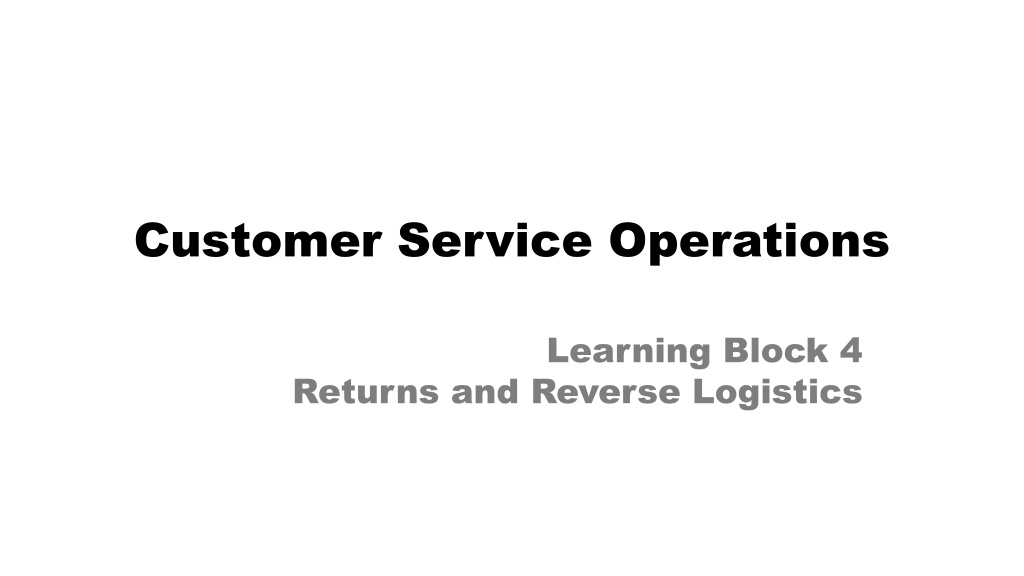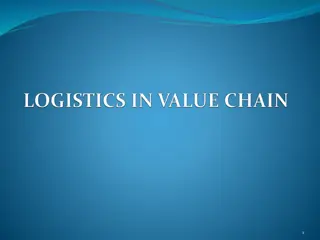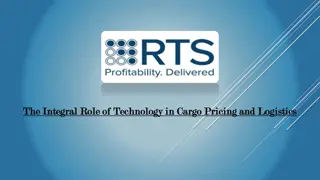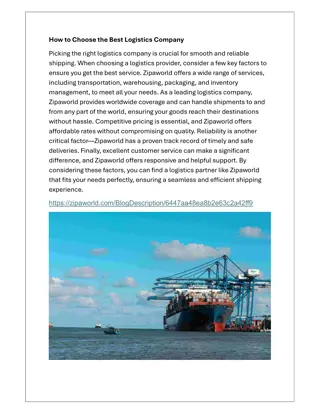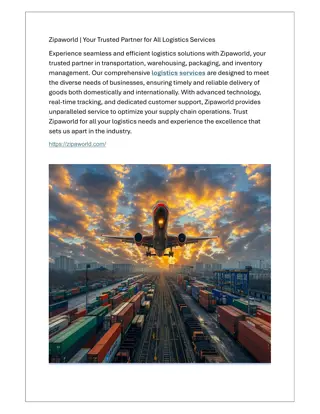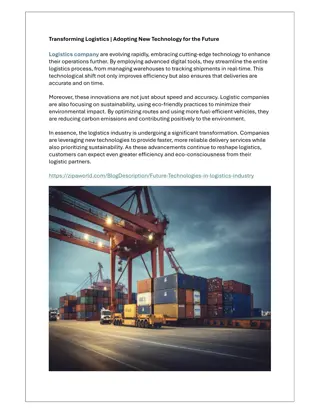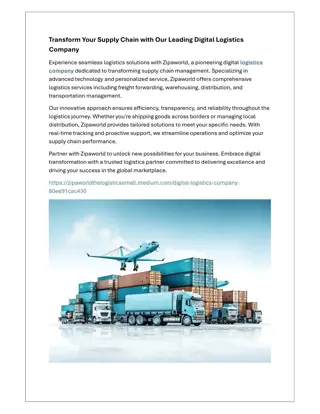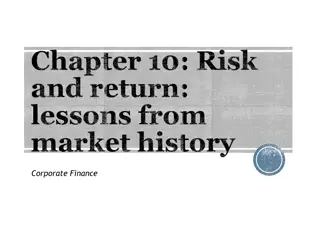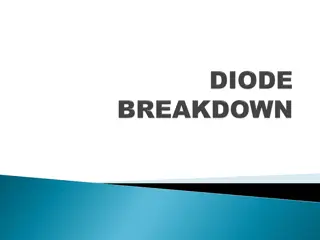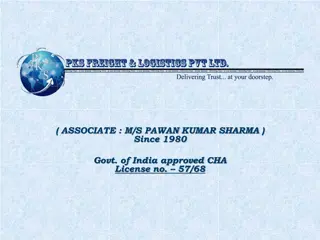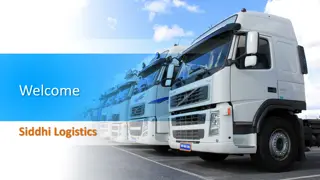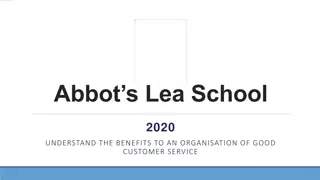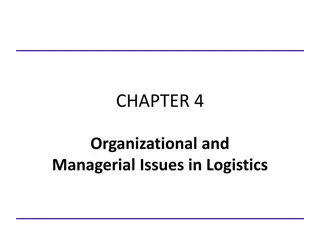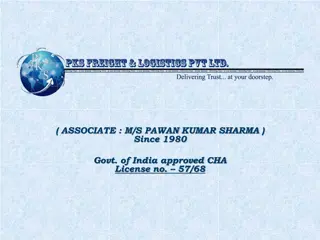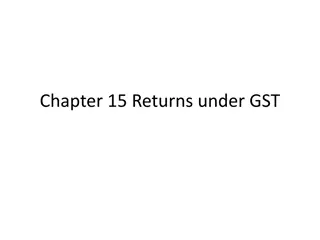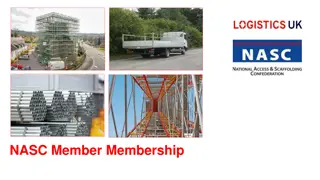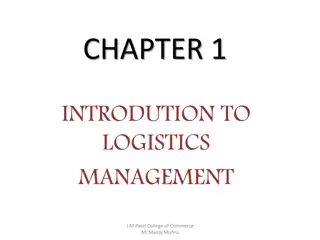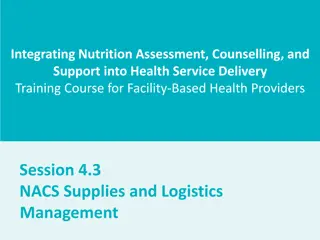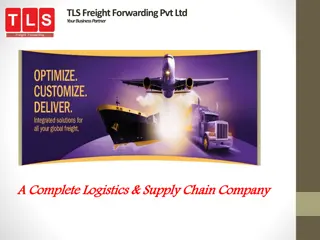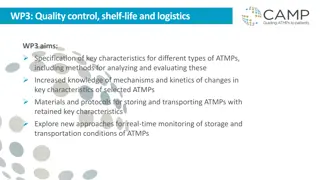Managing Customer Returns and Reverse Logistics in Customer Service Operations
This learning block delves into the processes, responsibilities, and metrics associated with managing customer returns and reverse logistics in customer service operations. It covers key aspects of the return process, employee responsibilities, metrics used, and best practices for effective management. Additionally, it explores the importance of reverse logistics in the supply chain and how companies handle product returns from dissatisfied customers.
- Customer Service Operations
- Returns Management
- Reverse Logistics
- Supply Chain
- Employee Responsibilities
Download Presentation

Please find below an Image/Link to download the presentation.
The content on the website is provided AS IS for your information and personal use only. It may not be sold, licensed, or shared on other websites without obtaining consent from the author. Download presentation by click this link. If you encounter any issues during the download, it is possible that the publisher has removed the file from their server.
E N D
Presentation Transcript
Customer Service Operations Learning Block 4 Returns and Reverse Logistics
Course Agenda Course Agenda 1. Customer Service Overview 2. Communication Skills in Customer Service 3. The Order Process 4. Returns and Reverse Logistics 5. Jobs and Legal Concerns in Customer Service 2
Learning Block Agenda Learning Block Agenda 1. Understand the key aspects of and employee responsibilities in the customer returns process 2. Recognize what encompasses reverse logistics, why reverse logistics are important, why reverse logistics are needed, and which key metrics are used in customer returns 3. Apply the key metrics used in customer returns functions 4. Create good key practices for the customer returns process
Description Description This learning block provides an overview of processes, procedures, and steps involved in managing customer returns. It also includes examples of employee responsibilities at different points in the customer return process and provides examples of metrics used in customer returns and reverse logistics. 4
Learning Objectives Learning Objectives Demonstrate knowledge of the overall order management process Understand how order management and order processing is accomplished Recognize how firms track and monitor orders throughout the supply chain Execute the steps in the order fulfillment process Implement key aspects of using different technologies, systems, and tools in the order process Evaluate the impact of effective customer service, especially in issue resolution Create good practices for the order process
Unit 1: Understanding Reverse Flows in the Unit 1: Understanding Reverse Flows in the Supply Chain Supply Chain Reverse logistics is the return of products by customers back through the supply chain. If products are not required by customers who received them or if products are defective, customers may return them in a reverse logistics flow. Today, most companies employ a policy of allowing returns if customers are dissatisfied with their purchases and would like to receive a credit or exchange them for different items.
Reasons for Returns Reasons for Returns Failed, defective, or damaged products Unwanted products Obsolete products, or those that are expired or near the end of their shelf life Products recalled due to quality or safety defects Apparel merchandise purchased online that does not fit
Forward Flow versus Reverse Flow Forward Flow versus Reverse Flow the forward flow of goods in the supply chain is more familiar because it is important in terms of filling customer orders and generating revenues. The reverse flow, or product return process, is viewed less favorably because it can result in negative cash flow and inventory restocking.
Unit 2: The Customer Return Process Unit 2: The Customer Return Process Customer Return Options Return Labels Return Material Authorization Warehouse Operations Refund, Restock, Refurbish Recycling
Returns Management Systems Returns Management Systems Specialized returns management systems, whether part of a warehouse management system or operating as a standalone system, can support the returns process to make this process more efficient. These systems and associated technology include: Interface with warehouse management systems Returns processing should be integrated into an existing warehouse management system. This allows for real- time inventory control, immediate inventory allocation, rapid picking from the returns area, and cross- docking to a shipping dock. Interface with accounting systems Any data collected about returned merchandise should be made available to accounting systems to serve as the basis for credit processing. This technology can be used to ensure credits are issued only after merchandise is inspected. It also reduces opportunities for crediting errors, which can happen more easily in manual systems. Handheld scanners As radio frequency equipment has proven to be useful in the warehouse environment, this technology is especially useful in the returns process. Figure 1. Handheld scanner. Developed by LINCS in Supply Chain Management Consortium. Figure 2. Warehouse. Developed by LINCS in Supply Chain Management Consortium. Figure 3. Accounting for returns. Developed by LINCS in Supply Chain Management Consortium.
Stages in the Customer Returns Process Stages in the Customer Returns Process Return Authorization: Customers obtain an RMA from customer service that approves the return and provides shipping and return instructions Stage 1 Figure 1. Return material authorization. Developed by LINCS in Supply Chain Management Consortium. Processing and Analysis: Information is entered into companies data systems regarding the reason(s) for the returns and the nature of the items; customers are also credited for their returns at this stage Stage 4 Figure 1. Processing and analysis. Developed by LINCS in Supply Chain Management Consortium. Receipt: Products are returned by customers and received by warehouses Stage 2 Figure 2. Receipt of goods. Developed by LINCS in Supply Chain Management Consortium. Disposition Activities: Decisions are made about what to do with returned items, which can be scrapped, repaired and returned, or replaced into inventory Stage 5 Figure 2. Disposition activities. Developed by LINCS in Supply Chain Management Consortium. Sort and Stage: Products are sorted according to the nature of returns and are staged for returns processing Stage 3 Figure 3. Sorting and staging. Developed by LINCS in Supply Chain Management Consortium. Processing and Analysis: Information is entered into companies data systems regarding the reason(s) for the returns and the nature of the items; customers are also credited for their returns at this stage Stage 4 Figure 4. Processing and analysis. Developed by LINCS in Supply Chain Management Consortium.
After After- -Sale Warranty Process Sale Warranty Process This process includes inspecting, sorting, handling disposition, and managing the enforcement of the warranty program for returned products. Sometimes companies use 3PLs to perform some or all of these procedures.
Unit 3: Industry Differences and Best Practices Unit 3: Industry Differences and Best Practices Differences exist among industries in a number areas, including the nature of returns and the types of products returned. Fashion: returns are common and often relate to ill-fitting sizes or customers simply changing their minds. In this industry, products can often be placed directly back into stock for resale. Pharmaceuticals: strict rules and regulations apply for batch lot control. In most cases, returns will often be scrapped or disposed of in a controlled manner.
Best Practices in Reverse Logistics Best Practices in Reverse Logistics Reduction of cycle lead times Information Systems and Technology Organization for returns Layout Asset Recovery Efficient returns processes and procedures
Unit 4: Key Metrics Used to Assess the Returns Unit 4: Key Metrics Used to Assess the Returns Process Process Many key metrics can assess the effectiveness and efficiency of the returns process, including: Length of time to process returned products Volume and value of products reclaimed and resold Percentage of material recycled Waste produced in the returns process, whether wasted time, wasted effort, or wasted materials Percentage of costs recovered Handling cost per return or item
Summary Summary
Practice Questions Practice Questions 1. What statement best describes reverse logistics? a) b) c) d) Reverse logistics is a not a part of supply chain management Reverse logistics applies mainly to manufacturing firms Reverse logistics involves operations related to the reuse or disposition of products and materials Reverse logistics has historically been viewed as a value-added activity within the supply chain 2. All of the following are generally part of the reverse logistics process except: a) b) c) d) Testing Disposing Refurbishing Manufacturing
Practice Questions Practice Questions 3. Which of the following is not a reason for product returns? a) b) c) d) Sales promotion Unwanted or no longer desired Obsolete Failed, defective, or damaged 4. When an item is shipped back by a customer, an important first step in the returns process is the creation of a(n): a) b) c) d) Packing slip Return label Invoice Bill of lading
Practice Questions Practice Questions 5. What are the stages in the customer returns process? a) b) c) d) Transportation, receipt, sort and stage, and disposition Receipt, sort and stage, processing and analysis, and scrap Receipt, sort and stage, processing and analysis Return authorization, receipt, sort and stage, processing and analysis, and disposition 6. Each of the following represents best practices in customer returns except: a) b) c) d) Avoidance of returns Asset recovery procedures Proper organization for returns No separate area for returns in the warehouse
Practice Questions Practice Questions 7. Why are there differences among industries regarding the nature and types of returns allowed? a) b) c) d) Most industries are concerned about international competition Some industries have products that are more tightly controlled for consumer safety Reverse logistics processes are not fully developed Companies are primarily concerned with sales, not returns 8. Which of the following is a key metric related to the returns function? a) b) c) d) Percentage of material lost Return on negative assets Amount of products scrapped Length of time to process returned products
Practice Questions Practice Questions 9. Why is the reverse flow, or product return process, viewed less favorably than the forward or initial sales flow? a) b) c) d) It results in negative cash flow and inventory restocking More resources are required Warehouses are not properly equipped to process returns Inventory systems do not easily accommodate returned inventory 10. Which of the following best describes the returns process for a company like Apple? a) b) c) d) Apple products are in such high demand that Apple has little need for returns processing The value of the products is low enough that Apple scraps the returns The quick and efficient processing of returns is critical to ensuring customer satisfaction Processing returns effectively and efficiently is not important to Apple
